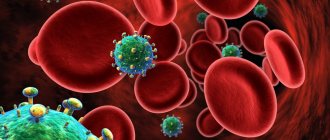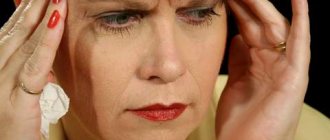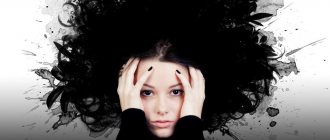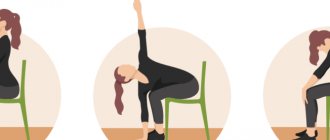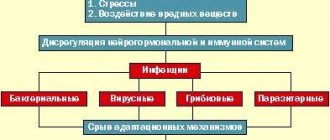In contrast to past ideas about depression as a triad of symptoms characterized by low mood, slow thinking and retardation of movements, the diagnostic criteria of modern classification systems (ICD-10 and DSM-IV) include a fairly large range of symptoms related to psychiatry, neurology, therapy and psychology.
At present, it is not recommended to contrast reactive or psychogenic depression with its endogenous forms, since the term “endogenous depression,” despite its long history, is quite controversial. Typically, this phrase refers to depressive states that develop on a constitutional basis, for which an organic etiology or connection with severe psychological stress cannot be determined. Sometimes the concept of “endogenous depression” is used in a descriptive sense to define a depressive syndrome characterized by low mood, lack of sensitivity to external stimuli, a tendency to cyclical fluctuations in the state during the day, lethargy, sleep disturbances usually with early awakenings, and lack of energy. In some cases, endogenous depression has the so-called vital manifestations. Vital depression is characterized by almost physical, precisely localized bodily suffering (usually in the chest area). Currently, due to lack of accuracy, the psychoanalytic term “depressive neurosis” (characterological depression) is not used. This concept has many meanings that do not correspond to the basic principles of psychoanalysis. The diagnosis of “depressive neurosis” (F34.1) was made in the absence of signs of endogenous depression, the presence of a cause-and-effect relationship with a stressful event or situation, as well as manifestations of a personality disorder. As can be seen, it is difficult to find a set of clinical manifestations that meet these criteria.
According to the International Classification of Diseases (ICD-10), there are different types of depression. The most common is a depressive episode (major depression), and bipolar depression is somewhat less common.
The core of the classification of depressive spectrum disorders is the concept of a depressive episode (F32) - a disorder (morbid condition) manifested by signs of depression.
A depressive episode (a single episode of depressive reaction, psychogenic depression, reactive depression), depending on the number of symptoms and their severity, can be mild, moderate or severe. Mild depression is quite difficult to distinguish from sadness, especially if the mood fluctuates throughout the day. With moderate depression, the presence of several symptoms no longer allows a person to show his usual activity. A severe episode (clinically significant depression) is further subdivided according to the presence or absence of mood-congruent or mood-incongruent symptoms of psychosis. In depression with signs of psychosis, which occurs in 15% of patients with depression, delusions and hallucinations appear.
Depression may be part of affective bipolar disorder (F31) (formerly manic-depressive psychosis), a disorder characterized by two or more episodes of disturbance in mood and activity levels. In some cases, these disorders are manifested by an increase in mood, a special feeling of joy, self-confidence, energy, irritability (apparently, depending on the characteristics of a person’s personality, a special form of depression may appear - manic), be accompanied by inappropriate behavior, and be the cause of irresponsible actions (wasting money, concluding unnecessary contracts, purchasing goods on credit, promiscuous sexual intercourse, etc.), in others - a decrease in mood and activity, reminiscent of typical forms of depression.
Quite rare forms of bipolar disorder are considered accelerated circular disorder (according to the American classification DSM-IV - four or more changes in mood phases during the year), mania with manifestations of dysphoria (“sullen mania”) and a mixed state (a frozen combination of depression and mania). It should be noted that accelerated circulatory disorder may be a consequence of chronic hypothyroidism. Some researchers classify bipolar disorder as cyclothymia.
Perhaps more common than bipolar disorder is recurrent depressive disorder (F33) - repeated depressive episodes (depressive reaction, psychogenic depression, reactive depression, seasonal depressive disorder). Severe forms of recurrent depressive disorder correspond to such previously used terms as the depressive type of manic-depressive psychosis (melancholia).
When classifying depression, chronic mood disorder or persistent mood disorders are also distinguished - dysthymia and cyclothymia.
Dysthymia (F34.1) is characterized by chronic depression of mood over several years, the severity or duration of episodes of which is insufficient to make a diagnosis of a recurrent disorder.
Cyclothymia, which usually occurs between the ages of 15 and 25, is a longer-lasting, “mild” form of bipolar depression in which the mood constantly changes from mild mania to mild depression and vice versa. With cyclothymia, attacks are short (several days) and irregular.
Depressive spectrum disorders also include other mood disorders (mixed affective episode) and adjustment disorders (short-term depressive reaction, prolonged depressive reaction, mixed anxiety and depressive reaction); depressive behavior disorder (F92.0) beginning in childhood or adolescence. Many conditions that could previously be classified within the framework of neurotic depression, when using the ICD-10 classification criteria, are placed under the rubric of neurotic disorders. According to domestic researchers, this trend narrows the possibility of studying depression in the neurotic register.
The domestic taxonomy of depressive spectrum disorders has traditionally been based on the classification of diseases (nosological classification). In this case, differentiation was carried out within the framework of the classical etiological and clinical dichotomy, which determines the endogenous (internal) or exogenous (external) nature of affective disorders. Endogenous depression usually included depression in schizophrenia, circular (bipolar), periodic, (recurrent, unipolar) and involutional depression. Psychogenic depression included neurotic, reactive and asthenic (depression of exhaustion, exhautive) depression. An intermediate place between endogenous and psychogenic depression was occupied by the so-called. endoreactive dysthymia - prolonged depressive states, in the first stages of which psychotraumatic factors played the main role, in subsequent stages - internal (endogenous). The author also identified somatogenic depression caused by exogenous organic factors and including organic (vascular, senile, post-traumatic, epileptic, etc.) and symptomatic depression (infectious, intoxicating, caused by internal diseases, etc.).
Domestic scientists have identified a large number of different types of depression: anesthetic depression or “participation poverty depression” with signs of mental anesthesia, painful insensibility; depression with delusions of accusation; anxious depression with motor agitation and accelerated speech; adynamic or inhibited depression; depression with symptoms of dysphoria or “dark, moody depression”; tearful depression with increased fatigue and hysterical symptoms; ironic depression ("smiling depression is characterized by irony, sarcasm about one's situation, expressing deep disappointment and loss of the basic values of life); apathetic depression; depression with derealization and depersonalization (feeling of internal and profound changes in one’s own personality, experiencing the illusory nature of the external world); psychasthenic depression, including various obsessive states; hypochondriacal depression with complaints of various pains and constant malaise. In accordance with the clinical features of the depressive syndrome, the author somewhat later distinguished simple (melancholic, anxious, apathetic) and complex (depression with delusions) variants of depression.
| Find out more: Symptoms of Depression |
Depressive states often occur in various mental disorders (comorbid, parallel, combined depression): in neurotic conditions (especially of a protracted nature), stress-related disorders (reactive, psychogenic depression), manic-depressive psychosis, schizophrenia, involutional psychosis, epilepsy, symptomatic and intoxication psychoses, as well as organic diseases of the brain (including depressive states caused by vascular disorders), depression in alcoholism and drug addiction (Tiganov A.S., 1974).
Most patients with depressive disorder have at least one other mental illness. Therefore, the question of the nosological independence of depression is quite controversial; its characterization at the syndrome level is more accurate, which meets the requirements of the modern classification of mental disorders.
How to determine if you have depression?
Pathology may appear after experiencing stressful situations. If there is no disorder, after the problem is resolved, the person returns to a good mood. But when the cause has been eliminated, and the person continues to feel apathy, depression and loss of strength, it is necessary to seek help from a specialist. Performance may also decrease.
You can determine the presence of depression yourself, but you should not self-medicate even at an early stage of development. This should be done by a doctor, since self-medication can only make things worse.
Depression in women often occurs postpartum, as their lives change dramatically, and sleepless nights add to their fatigue. This is where breakdowns and apathy appear.
When the pathology is in an advanced form, a person experiences the following symptoms of depression - not only bad mood and impotence, but also persistent disorders of the nervous system. There are also symptoms such as: a significant decrease in self-esteem, maladjustment in society, despondency and loss of interest in any events.
Physiologically, appetite changes, intimate needs and energy decrease, sleep and intestinal functions are disturbed (constipation, weakness, fatigue during physical and intellectual stress are observed), pain in the body (in the heart, in the muscles, in the stomach).
The patient exhibits signs of depression such as loss of interest in other people, a tendency to frequent solitude, refusal of entertainment, use of alcohol and psychotropic substances.
Mental signs of depression include difficulty concentrating, concentrating, making decisions, slowness of thinking, a pessimistic view of the future with a lack of perspective and thoughts about the meaninglessness of one's existence, suicide attempts, due to one's uselessness, helplessness, and insignificance.
Depressive paranoid syndrome
Depressive-paranoid syndrome is an acute course of a patient’s depressive state accompanied by acute delirium. With the development of an acute form of the disease, a person develops hallucinations, catatonic type disorders, as well as automatism at the mental level.
There is no specific reason why this syndrome may occur. The most common is the development of schizophrenia, and the formation of a paranoid complex acts as a consequence. In second place are strong experiences that create serious stress.
Four stages of development of depressive-paranoid syndrome can be distinguished:
- Development of a pessimistic outlook on life, loss of sleep and appetite, lack of sexual desire
- The emergence and development of suicidal tendencies, as a person loses the meaning of life
- An obsessive desire to commit suicide appears and it is impossible to convince a person otherwise
- At the last stage, a person develops persistent delusions. There is a certainty that he is to blame for all the troubles.
The development of paranoid depression occurs gradually and over a long period - about three months.
Causes of depression
The appearance of the disorder is not affected by age category or social class. Most often, depression appears against the background of stressful negative situations, with constant failures - then a person falls into despair from the inability to somehow influence the course of events.
But in addition to the social factor, severe psychological trauma can also lead to the development of depression, for example: family breakdown, death of a loved one, serious illness that affects not only the patient himself, but also his relatives. In this case, depression is called reactive.
The likelihood of depression increases with hormonal changes: during adolescence, after childbirth, with the onset of menopause, and also in old age. Can affect you emotionally and physically.
Another factor is brain damage and somatic pathologies. Patients who have suffered a stroke, suffer from a chronic lack of blood circulation in the brain, or after a traumatic brain injury often suffer from depression.
The causes of depression can manifest themselves as a result of side effects of medications (benzodiazepines, corticosteroids). Often this condition disappears on its own after stopping the medication.
Depressive hypochondriacal syndrome
Hypochondria is often classified as a psychosomatic disorder. As a rule, the patient does not show symptoms of the disease that could be confirmed by a diagnostic method. It is customary to identify several reasons as a result of which depressive-hypochondriacal syndrome may form:
- A person has experienced a situation of physical violence
- In childhood, a person suffered serious illnesses
- Individual specific features
- Hereditary predisposition.
People suffering from this syndrome feel confident that they have become hostage to a psychosomatic disorder or physical illness. Symptoms can vary widely, ranging from an ordinary feeling of fatigue to complete exhaustion and inability to carry out everyday activities. Often, hypochondriacal syndrome develops in patients who have recently lost a loved one, after divorce or other negative personal experiences.
Types of depression
- Neurotic – people with low self-esteem, insecure, and straightforward people often suffer. They constantly experience a sense of injustice, and this is where apathy arises.
- Clinical – bad mood, loss of energy, problems with appetite and sleep. Suicidal tendencies are often observed. This clinical picture can last at least 2 weeks.
- Vegetative – manifested by such symptoms as tachycardia, drop in blood pressure, tinnitus.
- Psychogenic - develops after severe psychological trauma - divorce, loss of a loved one, dismissal from work, betrayal, etc. Accompanied by mood swings, anxiety, and excessive sensitivity.
- Masked - often the disease manifests itself secretly. Apathy, solitude and decreased interest in life can only appear as negativity and fatigue accumulate.
- Asthenic – the condition is manifested by fatigue, sleep disturbance, emotional imbalance due to accumulated difficulties, stress, physical and psychological stress.
- Postpartum – usually occurs 10-14 days after delivery. The young mother shows an increased sense of excitement for the baby, and constant lack of sleep and fatigue further worsens the situation. In addition, the mother's condition is also affected by hormonal levels.
- Somatogenic – attacks occur due to disturbances in the endocrine system, the formation and proliferation of neoplasms, both benign and malignant.
- Alcoholic depression – depression is accompanied by excessive consumption of alcoholic beverages. The post-alcoholic state is accompanied by an uncontrollable craving for alcohol and an increase in withdrawal symptoms when giving up alcohol.
- Bipolar – the patient experiences a change from euphoria to a depressive, manic disorder. But in the period between these phenomena, caused by various factors: stress, loss of means of popularity, etc., a person lives a normal life and does not show symptoms of the disease.
How does depression develop in stages?
At first, the patient experiences a depressed state, which he himself attributes to fatigue, a hard work week, drinking alcohol and other reasons. At the same time, he wants to retire from others and at the same time is afraid of being left alone.
Then the stage of acceptance occurs: awareness of a dangerous condition occurs, the problem gets worse, the intensity of negative thoughts increases, the body and immune system malfunction.
The third stage - in the absence of adequate therapy, the patient loses control over himself, aggression increases.
Diagnosis and treatment of depression
—
To identify the disease, experienced specialists use short questionnaires - screening tools to identify symptoms: anxiety, anhedonia (loss of pleasure in life), suicidal tendencies. Thanks to this, it is possible to determine whether the patient has chronic depression, symptoms and methods of treating depression, what form it is and its severity.
To fully understand the picture of the disease, the doctor needs to become familiar with the symptoms that indicate depression, and not another psychological disorder.
To treat depression, you can contact the following specialists:
- Psychiatrist - treatment of depression with hypnosis, medications for acute mental pathologies - schizophrenia, mental retardation, epilepsy, as well as other less severe illnesses - neuroses, depression, alcoholism, drug addiction, etc.
- Psychotherapist - treatment is carried out through special therapy, which involves explanations, conversations, and searching for solutions to problems together with the patient.
- Psychologist – advises the patient, cannot prescribe medications or examinations. Clinical psychologists use modern testing methods to identify problems that cause psychological disorder.
The main directions of therapy in treatment are psychotherapy, pharmacotherapy, social therapy.
Cooperation and trust in the doctor are noted as a necessary condition for the effectiveness of treatment. It is important to strictly follow the prescribed treatment regimen, visit your doctor regularly, and give a detailed report of your condition.
Drugs to treat depression
—
To treat the disorder, antidepressants are used for anxious depression or when the pathology is accompanied by lethargy. Antidepressants are prescribed directly by a doctor and are not recommended to be taken on your own. The effect of many antidepressants appears two weeks after administration; their dosage for the patient is determined individually.
Bipolar depression is treated with insomnia. While it has a negative effect on a healthy person, in a patient with a psychological disorder, sleep deprivation, on the contrary, brings the psyche back to normal.
Moderate or mild forms of depression require the prescription of drugs on a light, natural basis (herbal).
Depressive syndrome in the clinic of occupational diseases
In everyday clinical practice, occupational pathologists and therapists often encounter various manifestations of neurotic, affective and other psychopathological disorders observed in patients with occupational diseases. A variety of somatovegetative symptom complexes, characteristic of both affective pathology and occupational diseases, differing in the polymorphism of symptoms, have either independent dynamics or are layered on the course of an occupational disease, making it difficult, in particular, for early diagnosis of occupational neurointoxications and other occupational diseases, the clinical picture of which is incl. and from disorders of the neuropsychic sphere [3, 4]. The structure of depressive disorders in occupational pathological practice: 1. Symptomatic (somatogenic) depression: – depressive disorder at the syndromic level as a manifestation of the neurotoxic effect of occupational factors or the neurotoxic effect of an occupational disease; – depressive disorder of the syndromic level as a consequence of the patient’s neurotic reaction to an occupational disease. 2. Psychogenic depression (as a consequence of chronic work stress, in response to significant psychogenic trauma or an adverse life event). 3. Somatized depression – depression that manifests itself under the guise of occupational diseases. Classification of depressive disorders. In ICD-10, the classification of depressive disorders is significant due to the large volume of diagnostic rubrics and their representation in various sections. A total of 60 diagnostic rubrics should be used, divided as follows. Affective disorders (mood disorders) (F30–F39) – 40 diagnostic headings. Neurotic, stress-related, and somatoform disorders (F40–F48) – 20 diagnostic categories (including mixed anxiety-phobic disorders). Diagnostic criteria for depression in occupational pathology practice Main symptoms: a decrease in mood compared to the patient’s normal norm is observed almost every day and most of the day, and also regardless of the situation; decrease (loss) of interests and the ability to experience pleasure in activities usually associated with positive emotions (anhedonia); decreased activity, increased (severe) fatigue and decreased energy. Additional symptoms: sleep disturbances of any type; changes in appetite (decrease or increase) with corresponding changes in body weight; recurrent thoughts of death, suicide, or self-harm; a gloomy and pessimistic vision of the future; ideas of guilt and self-deprecation; decreased self-esteem and feelings of self-doubt; decreased concentration, inability to concentrate, decreased ability to think, indecisiveness or hesitation when making decisions. Somatic symptoms (melancholic, vital): loss of interest and pleasure in usually pleasant activities; loss of emotional response to the environment and events that usually bring joy and pleasure; repeated early awakenings (two or more hours earlier than usual); increased depression and depression in the morning; objective evidence of clear psychomotor retardation or agitation noted by a stranger; pronounced decrease in appetite; weight loss (5% or more over the past month); pronounced decrease in libido. Protopopov's triad (sympathicotonia): tachycardia, mydriasis, constipation. The cause of persistent residual effects from the neuropsychic sphere, incl. and depressive reactions, with occupational intoxication, exposure to physical factors, and functional overstrain are dystrophic changes in the nervous system, most often in the brainstem-hypothalamic, brainstem-spinal or extrapyramidal structures. After acute intoxication, various cerebral syndromes (pseudoparalytic, schizophrenia-like, Korsakoff, epileptiform, hypothalamic, depressive, etc.) can be observed (Table 1). Symptomatic (somatogenic) depression. When exposed to mercury and its compounds, patients experience severe weakness, insomnia, increased irritability, tearfulness, and a tendency to depressive reactions. Hallucinatory-delusional phenomena, fear, depression and “emotional dullness” appear. In the Middle Ages, mercury poisoning was called the “mad hatter’s disease” because it was contracted by craftsmen who used mercury nitrate when making felt (one of the characters in Lewis Carroll’s famous book “Alice in Wonderland” was called Mad Hutter; his not entirely adequate behavior is explained by his professional occupation). With chronic lead intoxication, a picture of asthenic syndrome with epileptiform seizures, delirious disorders, and Korsakov's syndrome is observed. According to V.F. Akhmetova [5], in the clinic of mental disorders with mild chronic lead intoxication, organic asthenic disorders (F06.6) clearly prevailed, observed in 23 patients (71.8% of the total number of patients in this group). Depressive states (F06.32) were observed less frequently - in 7 (21.9%) patients and neurosis-like anxiety disorders (F06.4) - in 2 (6.3%) patients; as intoxication worsened, the proportion of severe ones increased, including . depressive disorders. Severe depressive reactions are characteristic of occupational intoxication with tetraethyl lead, manganese, thallium, carbon disulfide, carbon monoxide, gasoline, antibiotics, and organophosphorus compounds. The possibility of developing pronounced depressive reactions with prolonged exposure to industrial noise and vibration has been established. So, S.V. Kuznetsova [6] notes that with the combined effect of noise and vibration on the body, workers experience maladaptive mental disorders characterized by asthenic-depressive symptoms. The presence of pronounced depressive disorders in vibration disease with the presence of an alexethymic radical, depending on the type of vibration and the severity of the disease, has been noted [7, 8]. E.A. Ganovich [9] among Kuzbass miners with vibration disease revealed a deficit in the cognitive-mnestic sphere, manifested by difficult switching, instability, low productivity and volume of voluntary attention, episodes of getting stuck, a decrease in the rate of perception and the speed of visual orienting-search movements, modally nonspecific memory impairments, dysfunction of the frontal parts of the brain. The degree of severity of cognitive-mnestic deficit is directly dependent on the degree of severity of the pathological process of vibration disease. Patients with vibration disease have increased levels of neuroticism, personal and situational anxiety. A separate variant of depression in occupational diseases should be considered iatrogenic (neurotic, somatogenic) depression - a painful personal reaction to a situation associated with a severe course of an occupational disease (pulmonary heart failure, renal, liver failure, occupational neoplasms with multiple metastases, end-stage radiation sickness) . The severity of affective disorders (anxious-dysphoric affect, apathy, tearfulness) in neurotic depression correlates with the severity of the condition in an occupational disease. In occupational pathology, a fairly common syndrome is the syndrome of lumbosacral radiculopathy, accompanied by severe pain, which is typical for people engaged in heavy physical labor (functional strain of the spine), and is also diagnosed as one of the syndromes in vibration disease from exposure to general vibration. Severe pain syndrome provokes the development of depression and a vicious circle “pain – depression – pain – depression” is formed). The clinical picture of neurotic depression is dominated by low mood, adynamia, depression, tearfulness, a pessimistic assessment of treatment prospects, sleep and appetite disorders, accompanied by asthenic and hypochondriacal manifestations (patients complain of loss of strength, helplessness, inability to overcome weakness). Characterized by a persistent fixation on dysfunctions of the body, fear of deterioration of the condition, exacerbation of an occupational disease, increased pain. Psychogenic depression. Individuals in extreme professions, doctors in emergency medical care departments, and managers are characterized by the development of “emotional burnout syndrome,” which is characterized by increased excitability (impatience, haste, fussiness). Remembering names, numbers, dates presents insurmountable difficulties. As neurasthenia develops, patients become more and more lethargic, lazy, weak-willed, and apathetic. Mood swings with a tinge of melancholy increase, hypochondriacal symptoms arise, and extreme concentration on one’s painful sensations. The so-called exhaustion depression develops. Sleep disturbances and autonomic disorders are characteristic: headaches of a contracting nature (“neurasthenic helmet”), palpitations, shortness of breath, pain in the heart, vasomotor lability, severe dermographism, sweating, dysfunction of the gastrointestinal tract, decreased appetite, constipation. Depressive syndrome in this variant can be accompanied by phenomena of melancholic derealization and depersonalization up to painful mental anesthesia (anaesthesia psychica dolorosa - “mournful insensibility”) - a painful experience of internal devastation, loss of love for loved ones, disappearance of the emotional response to the environment (anesthetic depression). Somatized depression. The greatest difficulties are associated with the clinical qualification of mild, subsyndromal forms of depression, denoted by the synonymous concepts “masked”, “hidden”, “larded”. In such cases, the main manifestations (depression, melancholy, ideas of guilt, etc.) are erased, and some of them are completely absent. Accordingly, depression is often not recognized, since the leading place in the clinical picture is occupied by facade psychopathological disorders of other registers. The difficulty of correctly recognizing psychopathological disorders is further aggravated by the fact that the clinical picture of such depression includes the phenomena of somatization and comorbid somatoform disorders. In a significant part of masked depression, affective manifestations overlap with organo-neurotic ones (syndromes of vegetative-vascular dystonia, persistent algia - depressive pain syndrome (lumbodynia, fibromyalgia, abdominalgia), hyperventilation syndrome, intestinal motility disorders (obstipation, diarrhea)). There are also agrypnic (intermittent sleep with unpleasant dreams, early awakening with difficulty, requiring volitional effort, painful rise) and anorectic (morning sickness, lack of appetite and aversion to food, associated with weight loss, constipation) variants of masked depression. However, the opposite options are also possible, when the clinical picture is dominated by hypersomnia or increased appetite with weight gain. There are complaints of unstable blood pressure, “attacks” of dizziness, tachycardia; Such complaints are often combined. Facial pain can also mask depression: throbbing, drilling, aching sensations, one- or two-sided, diffuse, localized around the mouth, in the jaw area, forehead, cheeks, back. Often in occupational pathology it is necessary to carry out a differential diagnosis of pain syndromes characteristic of occupational diseases (for example, with pain syndrome due to lumbosacral radiculopathy), and fibromyalgia as one of the manifestations of “masked” somatized depression. Differential diagnosis of pain syndrome is difficult in cases of a common or similar chronic pain pattern, especially when accompanied by mental phenomena of depression, anxiety and asthenia, because The pain syndrome in lumbosacral radiculopathy is characterized by the so-called vicious circle “pain – depression – pain – depression”. Often “masked” somatized depression in patients working with occupational hazards imitates individual signs of occupational diseases (for example, vegetative, asthenic, cerebral disorders in those working with neurotoxic substances, local or general vibration, ultrasound). In this case (especially if the intensity of exposure to the occupational factor is insufficient - the level of exposure to the factor is below the maximum permissible limit or maximum permissible concentration, insufficient work experience in hazardous working conditions and the simultaneous presence of the main signs of depression), it is necessary to carry out targeted differential diagnosis. Complaints of difficulty breathing, a lump in the throat, a feeling of shortness of breath, a feeling of stopping breathing, pain in the heart or chest, a feeling of tightness in the chest and associated feelings of fear and anxiety - these symptoms in most cases are not associated with exposure to occupational factors and the subsequent development of occupational lung diseases and are a manifestation of hyperventilation syndrome - one of the manifestations of somatized depression. In the clinic of occupational diseases, quite often the symptoms of hyperventilation syndrome are interpreted as symptoms of occupational bronchial asthma, chronic dust bronchitis, chronic toxic bronchitis, pneumoconiosis, however, a comprehensive clinical and functional study does not reveal objective signs of an occupational disease, and additional signs from the psycho-emotional sphere, characteristic of for depressive syndrome. Patients with signs of masked depression may not be aware of a depressive disorder, remain convinced of the presence of some rare, difficult-to-diagnose occupational disease, a rare form of intoxication, and insist on numerous examinations in non-psychiatric medical institutions, often being in a state of permanent conflict with occupational pathologists. But with active questioning, it is often possible to identify pathological affect, subject to daily fluctuations, in the form of unusual sadness, despondency, anxiety or indifference prevailing in the morning, isolation from the environment with excessive fixation on bodily sensations. We observed patient N–v, 68 years old. Former mechanic at one of the defense plants. Occupational hazards include industrial noise, stress on the hands and elbow joints. Presents active complaints of cough, shortness of breath, pain in the heart, cervical and lumbar spine, increases in blood pressure, pronounced autonomic reactions, insomnia, attacks of tachycardia, dizziness, loss of appetite, weight loss, constipation. Connects these changes with the impact of production factors in the locksmith profession. An examination at the occupational pathology department revealed no signs of an occupational disease. Changes in organs and systems correspond to the age norm. I contacted the regional Ministry of Health and Social Development - according to the referral, I was consulted and examined at the Research Institute of Occupational Medicine of the Russian Academy of Medical Sciences, specialized research institutes of cardiology, gastroenterology, rheumatology, neurology, and immunology. The examination also did not reveal any serious changes in the organs and systems of the body that would indicate an occupational disease. Consulted by a psychologist, psychiatrist. A targeted questioning revealed a decrease in mood, interests, sleep disturbances, loss of appetite, weight loss, constipation, decreased self-esteem, perception of the future in “dark colors”, signs of a decrease in emotional reactions to current events, loved ones, increased depressive experiences in the morning, which allowed us to interpret the identified changes as “masked” somatized depression. The signs that contribute to establishing a diagnosis of somatized depression are: • incomparability of subjective feelings with objective research data, excessiveness, expressiveness, polymorphism, and sometimes pretentiousness of clinical manifestations; • comorbidity of various symptom complexes that never occur in the same disease; • discrepancy in the localization of receptor zones; • special dynamics with a tendency to sporadic manifestation of somatized reactions with variability, mobility, “volatility” (suddenness of appearance and disappearance) of symptoms; • modification and increase in symptoms under the influence of new (and especially individually significant) information.
Lack of awareness of occupational pathologists, general practitioners, and general practitioners about the signs and causes of depression leads to chronic depressive conditions, a significant decrease in the quality of life of patients and a worsening prognosis of an existing occupational disease. Difficulties in diagnosing depression are objective in nature, because... its manifestations are often atypical, mild, and are often considered purely in the context of an occupational disease that causes changes in the patient’s mood and activity. Treatment. In the clinic of professional intoxications, complexones are used - tetacin-calcium (calcium-disodium salt of ethylenediaminetetraacetic acid), pentacin (calcium-trisodium salt of diethylenetriaminepentaacetic acid), D-penicillamine (3,3-dimethylcystamine). For asthenovegetative syndrome, the treatment complex includes sedative, restorative, and stimulating therapy. Treatment of encephalopathy of toxic or vibrational etiology involves complex therapy aimed at improving metabolic processes in the brain. They use ascorbic acid, Cerebrolysin, nootropil, Riboxin, multivitamins, oxygen inhalations, and drugs aimed at improving cerebral circulation. In the treatment of depressive syndrome, tricyclic antidepressants (TCAs) (amitriptyline) are widely used, the use of which is associated with a number of side effects associated with their anticholinergic properties: persistent tachycardia, extrasystole, increased blood pressure, dizziness, constipation, tremor, and weight gain. Modern antidepressants are used: selective serotonin reuptake inhibitors (SSRIs) - fluvoxamine, fluoxetine, sertraline, paroxetine, citalopram, escitalopram; selective serotonin reuptake stimulators – tianeptine; selective serotonin and norepinephrine reuptake inhibitors - venlafaxine, duloxetine (in the presence of a pronounced anxiety component). If there are dissomnic disorders in the structure of somatized depression, including agrypnia (insomnia), an antidepressant of a new group of melatonergic series, agomelatine, is indicated. In addition, psychotherapeutic correction is carried out using cognitive behavioral therapy.
Literature 1. Podkorytov V.S. The problem of depression in general somatic practice // Archives of Psychiatry. 2003.T. 9. No. 1 (32). pp. 69–71. 2. Mikhailov B.V., Yakovtsova T.E. Current state of the problem of depressive disorders // Problems of medical science and education. 2006. No. 2. P. 65–69. 3. Smulevich A.B. Depression as a general medical problem: clinical and therapeutic issues // Psychiatrist. psychopharmacoter. 2006.T. 8. No. 3. P.12–18. 4. Kosarev V.V., Babanov S.A. Occupational diseases. M.: GEOTAR-Media, 2010. 368 p. 5. Akhmetova V.F. Organic mental disorders in chronic lead intoxication: Abstract of thesis. diss…. Ph.D. honey. Sci. Almaty, 2010. 28 p. 6. Kuznetsova S.V. Prenosological maladaptive mental disorders in persons exposed to noise and vibration: Abstract of thesis. diss. ...cand. honey. Sci. Kazan, 1998. 24 p. 7. Babanov S.A.. Vorobyova E.V. Psychological profile of patients with vibration disease // Occupational Medicine and Industrial Ecology. 2011. No. 1. pp. 11–14. 8. Kiryakov V.A., Sukhova A.V. Alexithymia in patients with vibration disease // Occupational Medicine and Industrial Ecology. 2009. No. 9. P. 19 – 21. 9. Ganovich E.A. Disorders of the cognitive-mnestic and affective-anxiety spheres in vibration disease among Kuzbass miners: Abstract of thesis. diss... cand. honey. Sci. Novokuznetsk, 2012. 24 p. 10. Kosarev V.V., Babanov S.A., Astakhova A.V. Pharmacology and drug therapy / ed. VC. Lepakhina. M.: Eksmo, 2009. 458 p.

